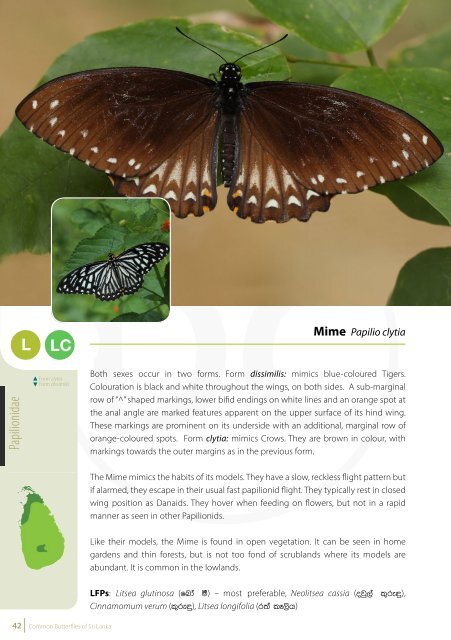Common Butterflies of Sri Lanka
Common Butterflies of Sri Lanka
Common Butterflies of Sri Lanka
You also want an ePaper? Increase the reach of your titles
YUMPU automatically turns print PDFs into web optimized ePapers that Google loves.
L<br />
LC<br />
Mime Papilio clytia<br />
Blue Bottle Graphium sarpedon<br />
M<br />
LC<br />
Papilionidae<br />
Form clytia<br />
Form dissimilis<br />
Both sexes occur in two forms. Form dissimilis: mimics blue-coloured Tigers.<br />
Colouration is black and white throughout the wings, on both sides. A sub-marginal<br />
row <strong>of</strong> “^” shaped markings, lower bifid endings on white lines and an orange spot at<br />
the anal angle are marked features apparent on the upper surface <strong>of</strong> its hind wing.<br />
These markings are prominent on its underside with an additional, marginal row <strong>of</strong><br />
orange-coloured spots. Form clytia: mimics Crows. They are brown in colour, with<br />
markings towards the outer margins as in the previous form.<br />
The sexes are similar. It has a narrow forewing and a serrated outer margin on its hind<br />
wing which extends into a short tail at the tornus. The upper surface <strong>of</strong> its wings is<br />
blackish brown with a median blue band divided into rectangular patches by black<br />
veins. The patches towards the forewing apex have a greenish tinge. A sub-marginal<br />
band <strong>of</strong> crescent shaped patches are present on its hind wing. Blue markings are<br />
visible in a similar manner on its underside, on a chocolate brown background with<br />
additional red patches on the hind wing.<br />
Papilionidae<br />
The Mime mimics the habits <strong>of</strong> its models. They have a slow, reckless flight pattern but<br />
if alarmed, they escape in their usual fast papilionid flight. They typically rest in closed<br />
wing position as Danaids. They hover when feeding on flowers, but not in a rapid<br />
manner as seen in other Papilionids.<br />
The Blue Bottle is a very fast flier who regularly flies at canopy level in low forests. It visits<br />
canopy flowers and sometimes descends to shrubs like Hedyotis fruticosa (jerKsh). It<br />
is rapid even at feeding, quickly jumping from flower to flower and returning to the<br />
same one again. It is regularly seen at hill tops where others are absent due to excess<br />
wind. Males engage in mud puddling, typically alone or in a group <strong>of</strong> 2-3.<br />
Like their models, the Mime is found in open vegetation. It can be seen in home<br />
gardens and thin forests, but is not too fond <strong>of</strong> scrublands where its models are<br />
abundant. It is common in the lowlands.<br />
It is commonly found in damp, densely wooded areas in the wet zone. It is occasionally<br />
found in the dry zone, but always in wet habitats, and especially in the rainy season.<br />
42 <strong>Common</strong> <strong>Butterflies</strong> <strong>of</strong> <strong>Sri</strong> <strong>Lanka</strong><br />
LFPs: Litsea glutinosa (fnda ó) – most preferable, Neolitsea cassia (ojq,a l=re÷),<br />
Cinnamomum verum (l=re÷), Litsea longifolia (r;a lE,sh)<br />
LFPs: Neolitsea cassia (ojq,a<br />
stenophylla (ksl ojq,)<br />
l=re÷q), Cinnamomum verum (l=re÷), Actinodaphne<br />
<strong>Common</strong> <strong>Butterflies</strong> <strong>of</strong> <strong>Sri</strong> <strong>Lanka</strong> 43















